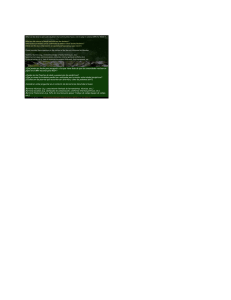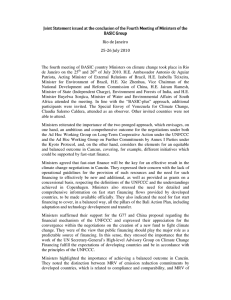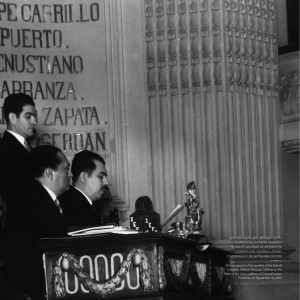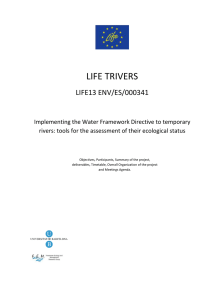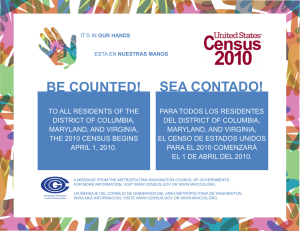NAMAS and its MRV Framework in Chile
Anuncio
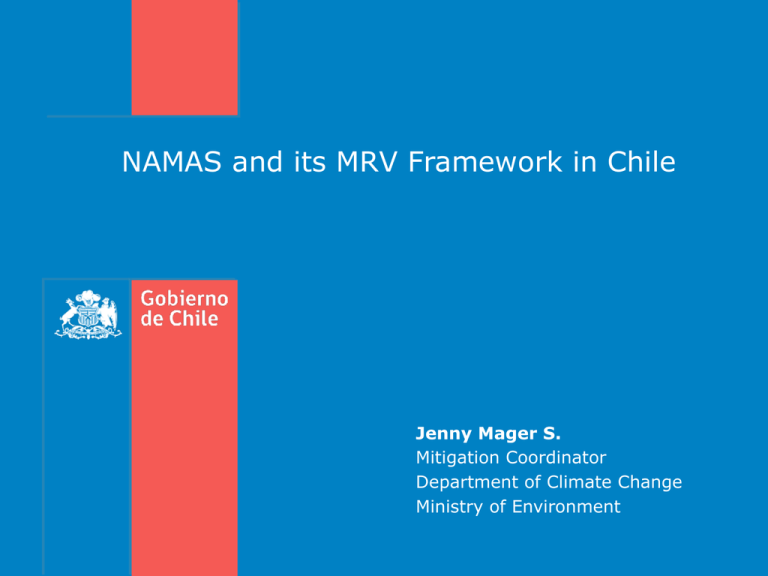
NAMAS and its MRV Framework in Chile Jenny Mager S. Mitigation Coordinator Department of Climate Change Ministry of Environment ¿Why MRV is relevant for Chile? • Monitor progress of implementa,on and effec.veness of plans and na,onal policies • Have clarity on what informa,on needs to be developed and presented to the UNFCCC • Manage and report informa.on related to interna,onal (financial) support received in a transparent way Others: • Avoid double coun,ng of emission • Priori,ze sectorial efforts • Iden,fy and solve methodological flaws • Iden,fy technical and financial needs Líneas de Trabajo para MRV en Chile MRV of Mi,ga,on Policies and Ac,ons MRV of GHG emissions and Sinks MRV of Support MRV of other mi,ga,on-­‐related ac,vi,es Chile’s Voluntary Mitigation Commitment Presented in August 2010 to the UNFCCC • Chile will take nationally appropriate mitigation actions to achieve a 20% deviation below the “business-as-usual” emissions growth trajectory by 2020, as projected from the year 2007. • To accomplish this objective Chile will require international support. • Energy efficiency, renewable energy, and Land Use Land Use Change and Forestry measures will be the main focus of Chile’s nationally appropriate mitigation actions. How we faced the challenge? • The Department of Climate Change (DCC) began in October 2010 an uprising of ideas and proposals for NAMAs of the major emiUng sectors providing a template developed na,onally • Several proposals for NAMAs were received, especially from the Ministries of Agriculture, Energy and Transport, which formed the star,ng point to have an ini,al porXolio of NAMAs in Chile. • In Durban (COP17), Chile took an ac,ve role in proposing what should be the minimum informa,on to be provided by developing countries in order to registry, under UNFCCC, a NAMA seeking interna,onal support • Chile was the first country that registered a NAMA to the UNFCCC in October 2012 Public NAMA workgroup • In October 2013 the “Public NAMA workgroup” was created as the first group of government ins,tu,ons to work on the design and implementa,on of NAMAs. Objec,ves : • Increase the number of new NAMAs in Chile • Involving new key sectors • Promote NAMAs na,onally • Iden,fy Capacity Building Needs Public NAMA workgroup Needs and barriers iden,fied: -­‐ Need for ongoing technical support and con,nuous capacity building ac,vi,es. -­‐ Need for a generic framework to standardize, as far as possible the NAMA MRV systems. As a final agreement, it was decided to con,nue the training and outreach ac,vi,es and bilateral technical support in the process of registering NAMAs to the UNFCCC Generic NAMA Framework: Considerations What we need to know about Implementa,on of NAMAs: -­‐ Is it mee,ng its goals? -­‐> (Impact, Reduc,on es,mated, ,me) -­‐ Is the NAMA needing some adjustments? Which Ones? Generic NAMA Framework: Considerations Interactions and Synergies GHG Projections National GHG Commitments (e.g. INDC) NAMA MRV Sustainable development strategies GHG Inventory Generic NAMA Framework: Considerations Coherence • GHG inventory and GHG Impact of the • Assump,ons for baseline in projec,ons • Comparability among NAMAs • Good Prac,ces However MRV systems must be FLEXIBLE!! How to ensure coherence? • Common Technical focus WRI Policy and Action Standard • Defined Process (Who, What, When?) • Centralized coordina,on involving all relevant ins,tu,ons • Engagement of Sectorial experts • Reports Valida,on • Templates MRV Framework Objetivos y líneas base MMA DCC Desarrollo del plan MRV Dearrollad or de la NAMA Desarollador de la NAMA Indicadores para la NAMA Validación y aprobación plan de MRV Monitoreo de los impactos MMA DCC Diseño y aprobación del MRV Operación del MRV Informe sobre los impactos Validación e informe a nivel nacional Evaluación de los procesos de MRV y retroalimentación 12 Leyenda Design and approval of the MRV system MMA DCC Desarrollador de la NAMA Diseño y aprobación del MRV Ministerio del Medio Ambiente, Departamiento del Cambio Clima,co Desarollador de la NAMA Indicadores para la NAMA Proceso 1 –Selección de indicadores Objetivos y líneas base para los indicadores Proceso 2 – Líneas base y objetivos Desarrollo del plan MRV Plantilla 1: Plan de MRV Validación y aprobación del plan de MRV Proceso 3: Validación y aprobación plan MRV 13 Operation Ministerio del Medio Ambiente, Departamiento del Cambio Clima,co Desarollador de la NAMA Monitoreo de los impactos Proceso 4: Evaluación de los impactos Informe sobre los impactos Plantilla 2: Informe de MRV Anual Validación e informe a nivel nacional Plantilla 3: Informe Nacional sobre el avance de las NAMAs MMA Desarrollador de la NAMA Operación del MRV Leyenda Evaluación de los procesos de MRV y retroalimentación Proceso 5: Mejora Continua 14 Desarrollador de la NAMA MMA DCC Desarrollador de la NAMA MMA DCC Diseño y aprobación MRV Operación MRV Indicadores para la NAMA Proceso 1 –Selección de indicadores Objetivos y líneas base para los indicadores Proceso 2 – Líneas base y objetivos Desarrollo del plan MRV Plantilla 1: Plan de MRV Validación y aprobación del plan de MRV Proceso 3: Validación y aprobación plan MRV Monitoreo de los impactos Proceso 4: Evaluación de los impactos Informe sobre los impactos Plantilla 2: Informe de MRV Anual Validación e informe a nivel nacional Plantilla 3: Informe Nacional sobre el avance de las NAMAs Evaluación de los procesos de MRV y retroalimentación Proceso 5: Mejora Continua Leyenda Timeline of the next reports BUR Inform e MRV Informe anual avances NAMAs Plan.lla NAMA 2016 Ministerio del Medio Ambiente, Departamiento del Cambio Clima,co Desarollador de la NAMA BUR Inform e MRV Informe anual avances NAMAs 2017 Inform Informe anual e MRV avances NAMAs Plan.lla NAMA 2018 Inform e MRV 2019 Informe anual avances NAMAs Relationship between this work and INDC • Common Nature: NATIONALLY APPROPIATE Lesson learned: ü Key element to consider in the implementation of Mitigation actions NAMAs Tool for implementa,on Compromiso INDC 20/20 Agregated effort indicator ü More transparent processes ü Continuity iof the approach and relevance of Climate Change in Public policy Challenges • Develop a finan,al strategy for NAMAs and a MRV of support • Diffusion of the MRV framework as a useful tool of progress management • Develop an integrated paXorm of informa,on for emission reduc,ons and sinks (Na,onal registry of Mi,ga,on Ac,ons) to simplify the report process Thanks for your attention Jenny Mager Santos Department of Climate Change Ministry of Environment
